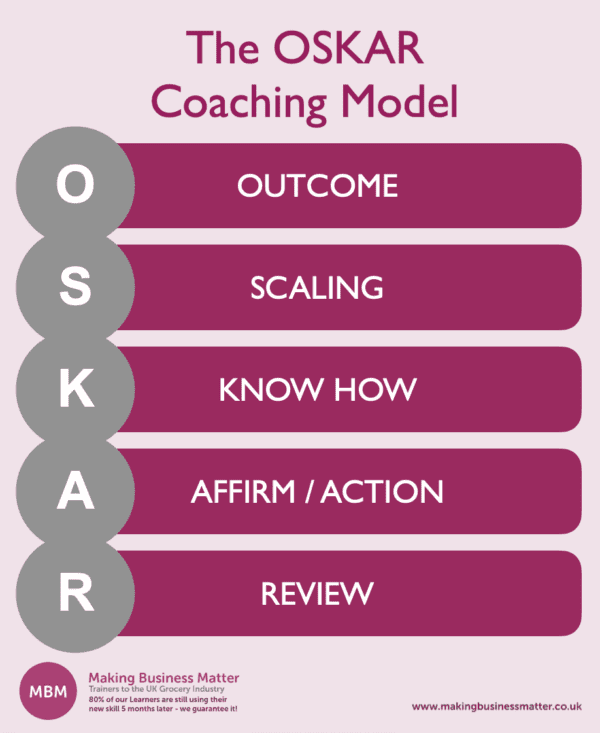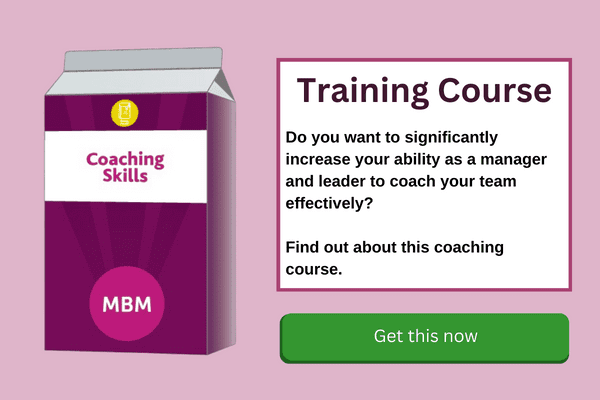Coaching Is Key
Whether you are a new supervisor or an experienced leader, coaching is a key leadership skill that you need in your toolkit. However, there are many different tools and models that we can use for effective results. In this article, we are focusing primarily on the OSCAR Model. In saying that, the OSKAR model and more will also be discussed throughout this article.
At MBM we want to give you the leadership skills you need to strive as a leader and achieve your goals. Coaching others effectively will help you head in the right direction for success to be realised.
So, let’s take a look at the OSCAR model, comparisons to a couple of other models, the meaning and importance of coaching, how to use the OSCAR model of coaching effectively as well as top tips for being a coach.

The OSCAR Model
So, how can we really know that we’re coaching effectively? That can be a challenge for many leaders taking on a coaching role. That’s where we want to tell you all about the OSCAR model for coaching. A tried and tested model that was developed over 20 years ago by Whittleworth and Gilbert in 2002. At the time other models did exist. However, they aimed to build on the 1990s GROW model (another coaching model we will review a bit later in the article).
Now, let’s break down the acronym to fully understand what we’re dealing with in the OSCAR model.
- O – Outcome
- S – Situation
- C – Choices/Consequences
- A – Actions
- R – Review
Now, let’s delve deeper into each of these terms to fully understand the part they play in the model. Ideally, you will finish this article with a clear and concise understanding of what the model is and how to use it best.
O- Outcome
So, the first step of the OSCAR model is to have the end goal in mind. Unlike some other models, this one ensures that coaching is aimed at reaching a desired result. These outcomes can be for the end of each session or the coaching programme as a whole.
Here, we can ask questions such as:
- What do you hope to achieve from this session?
- For you, what does the long-term outcome/goal look like?
- In terms of success, how can we work together to achieve that?
In this section of the OSCAR coaching model, we create clarity. Also, we have a direction for the rest of the model to follow and build from.
S- Situation
Next, we look at where we are right now. For this to be achieved, complete the following steps.
- First, clarify the current skills/knowledge levels.
- Now, create an understanding and awareness for the coachee of their present situation.
- Then, ensure the coachee acknowledges their current situation.
So, by doing all of this, you create buy-in with the coachee. An important part here is to acknowledge the feelings of the coachee. You must take time to talk about what the situation feels like for them.
Here, ask some of the following questions:
- How do you feel about the current situation?
- What has been happening recently in your role?
- Where are you in terms of your goals and objectives?
- How do you think your current situation is impacting those around you?
- What are some changes you think need to be made?
Ideally, encourage the coachee to answer these questions first before providing your feedback. In that way, you allow them to recognise their gaps as well as their strengths. Remember, listen more than you share as a coach to get better results.
Sticky Learning ® is 7 times more effective than 1-day training courses. Plus, you will get a Chain of Evidence proving your Return on Investment. Discover soft skills training that changes behaviours long term.

C- Choices/Consequences
So, in this part of the OSCAR model, the coach guides the coachee into understanding ways they can achieve their ideal outcomes. Continue to encourage the coachee to share. Allow them the opportunity to discover the options available to make improvements or develop. However, guide them along the way if they are veering off course.
Here, use some of the below questions to help direct the conversation:
- What choices do we have to move forward?
- How will these choices impact others?
- What are the best options available to achieve your outcomes?
Remember, guide the conversation without taking over. Give your coachee a voice. Ensure they are coming up with the options. Spoon-feeding doesn’t help anyone in the end.
A- Actions
Now, this step is important to start putting ideas into practice. Ideas are great, however, action is required. Ensure any steps you agree on are converted into SMART goals to work on. Remember, create action steps that are motivational rather than overwhelming. When we set goals that overreach the capabilities of the coachee, we set them up to fail.
Again, here are questions to use at this stage of the process.
- What action steps will you take moving forward?
- How will you apply these action steps?
- Who do you need to support you for each of these steps?
- When will we review each of these goals?
Ultimately, commit all action steps to a written action plan. Use this as your written commitment to the agreed steps. Also, use this template for the next step when reviewing progress.
R- Review
Finally, we need to review how the action plan is moving forward. So, work with the action plan that was created in the last step of the OSCAR model. Here, hold regular meetings to discuss the progress. Ensure the sessions involve 2-way conversations, with the coachee providing actual examples of how the plan has worked. Discuss any barriers they have faced along the way. Also, identify where gaps continue to exist that need development.
In this section, use the following questions:
- How is your plan progressing?
- What barriers have you faced along the way?
- How did you manage to overcome those barriers?
- Where do we go from here?
- How are you feeling about the progress to date?
There are many questions we can ask in this stage of the model. In turn, these will lead us back to the first stage “Outcome” where new areas of development can be identified.

OSCAR Model vs OSKAR Model
So, some of you might be asking what is the difference between the OSCAR model for coaching and the OSKAR model. Well, let’s have a look to see.
The OSKAR model was developed in 2002 (yes the same year as the OSCAR model) by Jackson and McKergow. There are 2 main differences in terminology for the acronyms, however, the main concepts are similar.
Both models have O – Outcome, A – Action, and R – Results, however, there are 2 small differences.
S – Scale
In the OSKAR model, the S stands for Scale. Here, the coach creates a scale to give a value to how close the coachee is to achieving their goal. Similar to the OSCAR model, concentrate on the current situation of the person involved in realistic terms.
K – Know-how
In this stage of the OSKAR model, the K is for Know-how. For this model, focus on what the coachee needs to move forward and develop. Identify the skills, knowledge, etc. that are required for them to achieve.
As you can see from the descriptions, the models are very similar.

OSCAR Model Vs GROW Model
There are many coaching models out there. One commonly known model is GROW, but, how do the 2 models differ?
The GROW model acronym stands for:
G – Goal
Use this first step to identify where the coachee wants to go. Also, identify what they want to achieve as a result of the coaching session or programme.
R – Reality
Now, create an understanding of where they are right now. Acknowledge the reality of the current situation.
O – Options
Then, discuss the options available moving forward.
W – Will/Wrap-Up
Finally, agree on the steps to be taken for improvement and development.
So, are the models really that different?
They are very different in some ways. Here, let’s see what the main differences are.
#1: OSCAR Model Deep Dive
Here, the OSCAR model differs from GROW with more emphasis on steps for Choices/Consequences and Review that are missing in the latter model. As a result, the coaching model OSCAR is more in-depth.
#2: Create SMART Goals
The OSCAR model encourages the use of SMART goals in the Action stage. Therefore, this creates stronger objectives for the coachee to work towards. Unfortunately, this is missing from the GROW model as a focus point.
#3: Regular Reviews
Finally, an important difference is the need for regular review of the coachee’s progress. Again, this is not properly emphasised in GROW. However, OSCAR makes it a main point of the 5-step model.
From experience, I know how these small but important differences can impact the coaching experience. In fact, I have used both models with differing results. As such, I choose to use the OSCAR model rather than the GROW model based on the structure it offers.

Meaning of Coaching
There are many definitions out there regarding coaching and the role of a coach. Here, let’s look at some keywords and phrases that will give us an immediate understanding of what coaching is.
#1: Experienced Person Supports a Learner
Here, the coach has the role of supporting others in their team to learn something new. Coaches focus on the individual or group needs that have been identified.
#2: A Method of Achieving Formal Goals
Now, coaching is done formally with goals and objectives that need to be met. Coaching is not done without a proper plan in place and targets to achieve.
#3: Development of Skills and Knowledge
So, when we talk about coaching it is about the development and enhancement of new or existing skills and knowledge. In this way, the coach has their areas of development mapped out with structure in place for how the skills or knowledge will be achieved.
#4: Enhancement of Productivity and Performance
Then, the coach needs to focus on creating opportunities for these different coaching sessions to work on improved productivity and performance.
So, as you can see, just from these 4 areas, the coach has a lot to do and a big role to play. However, you may still be asking yourself why coaching is important. Well, that’s what we’re discussing next.

Importance of Coaching
We should never underestimate the importance of coaching, regardless of the model we use. There are many reasons why coaching is important. Here are numerous reasons we want to highlight to show the difference coaching can make when done effectively. Here we see that coaching creates:
- Improved retention
- Better results
- Enhanced performance
- Greater productivity
- Improved employee engagement
- More effective communication
Obviously, these are all great reasons to get coaching right and make it happen.
OSCAR Model Usage
So, how do we use the OSCAR model of coaching to really achieve results? There are several considerations to get the best use of the OSCAR model in coaching programmes for individuals and groups.
Remember:
#1: Coachee Takes Charge of Their Own Action Plan
First, this model, OSCAR, allows the coachee to take charge of their own action plan. Use the steps correctly for the coachee to be the creator of their plan.
#2: Keeps Coaching as a Continuous Process
Now, because of the link from the last stage of “Review” back to the first stage of “Outcome”, the process continues as a continuous activity. Here, use the review stage to recognise future steps. Also, encourage the coachee to embrace ongoing development rather than one-off activities.
#3: Allows for Focus on Short and Long-term Goals
The OSCAR model is useful for both short-term and long-term goals and objectives. Therefore, this model, in comparison to others is adaptable to both. Not all models work that way.
#4: Offers Support Without Directing
Now, the coach doesn’t lose their role. In fact, this model ensures that the coach stays as the coach rather than the director of the process. Therefore, coach rather than spoon feed for better possible results. Allow them to take the lead while continuing to offer support.
#5: Develop Future Coaches
Ideally, proper use of the model creates future coaches for others. As a result of an effective experience, they develop their own desire to help others with the same process. In fact, many coachees who have a positive experience using this model become coaches themselves.
Coaching for Results – Top Tips

So, there you have it. The OSCAR model for coaching is a valuable tool which I can highly recommend from having used it myself over the years in different leadership roles. It is very important to remember some of the following practices.
- Build rapport and trust with the coachee.
- Listen actively through the stages of using the model.
- Allow the coachee to take the lead in their plan.
- Encourage the coachee to share their feelings and ideas.
- Find the coaching tool that suits you and the coachee best.
- Give feedback during the different stages.
- Provide support throughout the entire process.
- Acknowledge successes and improvements along the way.
- Use open questions to get the coachee to share more.
- Understand the importance and difference that coaching can make in the organisation.
- Make coaching available for everyone who needs it.
Here, use these top tips to be a better coach and achieve better results. In that way, everyone experiences a more effective process.
Coaching and MBM
Now, to wrap up, have a look at everything we have to offer here at MBM for your coaching needs. This article is simply one of the many resources available. Check out our amazing coaching cards, covering more than 30+ topics. Also, we have training programmes available for you and your organisation that can help develop the necessary coaching skills. Finally, there are more articles to enjoy and learn from throughout our blog. Check them out!
At MBM, we are fully committed to ensuring you have everything you need to develop as a coach and leader. Therefore, stop what you’re doing and find more resources that will fully unlock the coach in you.




